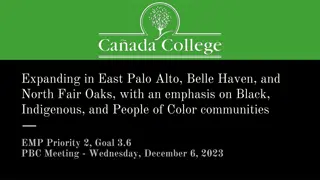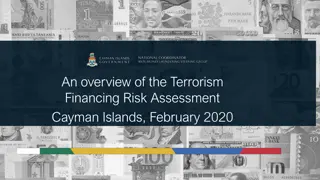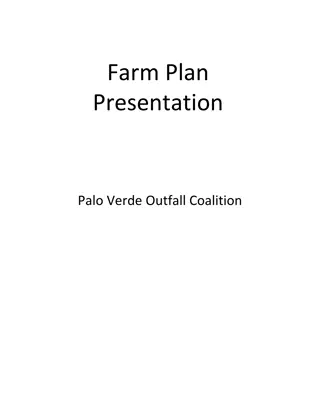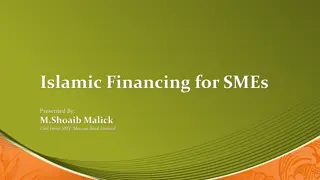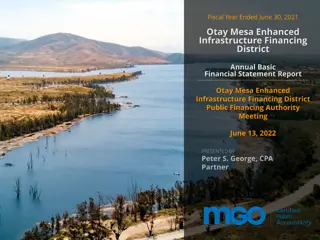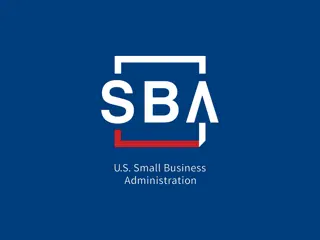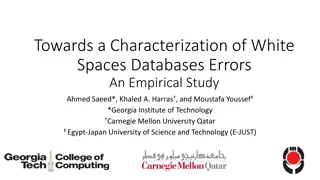Palo Alto Grade Separation Financing White Paper
White paper on grade separation financing presented to Palo Alto City Council Rail Committee Meeting by Economic & Planning Systems, Inc. Includes project cost scenarios, funding considerations, and potential sources of financing.
Download Presentation

Please find below an Image/Link to download the presentation.
The content on the website is provided AS IS for your information and personal use only. It may not be sold, licensed, or shared on other websites without obtaining consent from the author.If you encounter any issues during the download, it is possible that the publisher has removed the file from their server.
You are allowed to download the files provided on this website for personal or commercial use, subject to the condition that they are used lawfully. All files are the property of their respective owners.
The content on the website is provided AS IS for your information and personal use only. It may not be sold, licensed, or shared on other websites without obtaining consent from the author.
E N D
Presentation Transcript
Palo Alto Grade Separation Financing White Paper presented to Palo Alto City Council Rail Committee Meeting presented by Economic & Planning Systems, Inc. November 29, 2017 Oakland Sacramento Denver Los Angeles Economic & Planning Systems, Inc. One Kaiser Plaza, Suite 1410, Oakland, CA 94612 510.841.9190 510.740.2080 fax
Presentation Overview Purpose and Context Project Cost Scenarios Types of Funding & Financing Considered Voter Approved Taxes Value Capture Tool Other Local Sources (not quantified) Regional Funding (e.g., Measure B) State and Federal Funding 1
Study Purpose and Context Purpose Preliminary consideration (and quantification where possible) of potential grade separation funding and financing to inform the planning process Qualifications and Limitations Projections based on readily available information and generic assumptions Some sources may be politically infeasible and/or mutually exclusive Funding landscape is subject to change based on economic, political, legal, and other factors. 2
Preliminary Project Cost Scenarios Total Estimated Cost Range Option Low High 1a: Open Trench, City Limit to City Limit $2,400,000,000 $2,900,000,000 1b: Cut & Cover Tunnel, City Limit to City Limit $3,300,000,000 $4,000,000,000 1c: Twin Deep Bored Tunnels $2,800,000,000 $3,400,000,000 2a: Open Trench, Under Meadow and Charleston (2% Grade) $750,000,000 $1,000,000,000 2b: Open Trench, Under Charleston Only (2% Grade) $500,000,000 $700,000,000 Individual Grade Separations Churchill lowered under Caltrain and Alma Meadow lowered under Caltrain and Alma Charleston lowered under Caltrain and Alma Subtotal $98,000,000 $93,000,000 $111,000,000 $302,000,000 $200,000,000 $156,000,000 $167,000,000 $523,000,000 3
Local Taxes Requiring Voter Approval General Tax: The revenues from a General Tax are expended at the discretion of the local government s governing body on any programs or services. Requires a simple majority (50% +1). Special Tax: The revenue from special tax are dedicated to a specific purpose as defined in the ballot initiative. Requires super-majority (66% +1) A/B Strategy : General purpose tax measures accompanied by an advisory measure indicating the recommended use for the funds. 4
Voter Approved Tax Preliminary Quantification Funding Potenial Key Assumptions Funding Source / Mechanism Low High Low High $143,000,000 $713,000,000 .05% Increase .25% Increase Property Tax Bond $50 / Unit or 1,000 Sqft. $100 / Unit or 1,000 Sqft. $22,480,000 $44,950,000 Parcel Tax $23,730,000 $59,330,000 .10% Increase .25% Increase Add-on Sales / Use Tax $15,980,000 $47,930,000 1% Increase 3% Increase Transient Occupancy Tax $10,840,000 $32,510,000 .05% Increase .15% Increase Property Transfer Tax $24,940,000 $74,810,000 1% Increase 3% Increase Utility Users Tax $10 / private sector job $40 / private sector job $8,510,000 $34,050,000 Business License Tax 5
Value Capture Tools Description Funding tools and techniques that extract a portion of private sector benefit resulting from new infrastructure, amenities, or development enabled by the public sector. Potential Grade Separation Benefits Improved access and circulation to nearby property owners New development opportunities (e.g., air rights ) Reduced sound and visual impacts 6
Map of Primary Benefit Area(s) Churchill Ave. Meadow Dr. Caltrain Corridor: Primary Benefit Area Charleston Rd. Secondary Benefit Areas 7
Value Capture Tools -- Preliminary Quantification Funding Potenial Key Assumptions Funding Source / Mechanism Low High Low High 500 housing units + 100K commercial sq. ft. (Value Capture = 10% of Finished Market Value) 2,000 housing units +750K commercial sq. ft. Development Agreements, incentive zoning, and/or P3 $50,000,000 $235,000,000 @ 3% Avg. annual increase in AV @ 5% Avg. annual increase in AV Enhanced Infrastructure Financing District (EIFD) $13,230,000 $24,200,000 Mello-Roos Community Facilities District (CFD) $200 / unit or 1K sqft. $600 / unit or 1K sqft. $11,520,000 $34,560,000 $14,300,000 $20,000,000 15 year total 20 year total Development Impact Fees $.25 / departing trip $1.00 departing trip $2,460,000 $9,830,000 Caltrain Fare Surcharge 8
Other Local Sources (not quantified) Local parking fees: Allocate a portion of future parking fees to grade separation Transportation Network Company Fees: Registration fee applied to company shuttle and ride share (e.g., Lyft, Uber) Roadway User Fees: Electronic auto charge on selected access points/lanes (e.g., Alma St.) Utility ROW Fees: Lease modern utility bank/conduit along Caltrain/Alma St. corridor 9
Selected Regional, State, or Federal Sources Funding Source / Mechanism Funding Potenial Key Assumptions / Factors Description Low High Sales tax measure approved by 2/3rds Santa Clara County voters in 2016 with $700 million for grade separationin 3 cities 30-Year Cumulative Total $350,000,000 $395,500,000 Measure B One-Time Funding of 15 years (based on the CPUC priority list) State funds to local agencies for grade separation projects, total of about $15 million annually. $2,000,000 $5,000,000 Section 190 15-year total based on fair shar allocation of projected funding for San Jose to SF The HSRA receives its funding from a variety of sources and has already contributed to grade separation projects $155,000,000 $179,000,000 HSR Authority 10
Other State/Federal Sources (not quantified) State Sources/Programs Caltrain Sales Tax Initiative State Infrastructure Bank (IBank) The Statewide Community Infrastructure Program (SCIP) State Road Repair and Accountability Act (SB 1) Federal Sources/Programs Infrastructure For Rebuilding America Grants Transportation Investment Generating Economic Recovery (TIGER) grant Transportation Infrastructure Finance and Innovation Act (TIFIA) Loans The Railroad Rehabilitation & Improvement Financing (RRIF) program 11
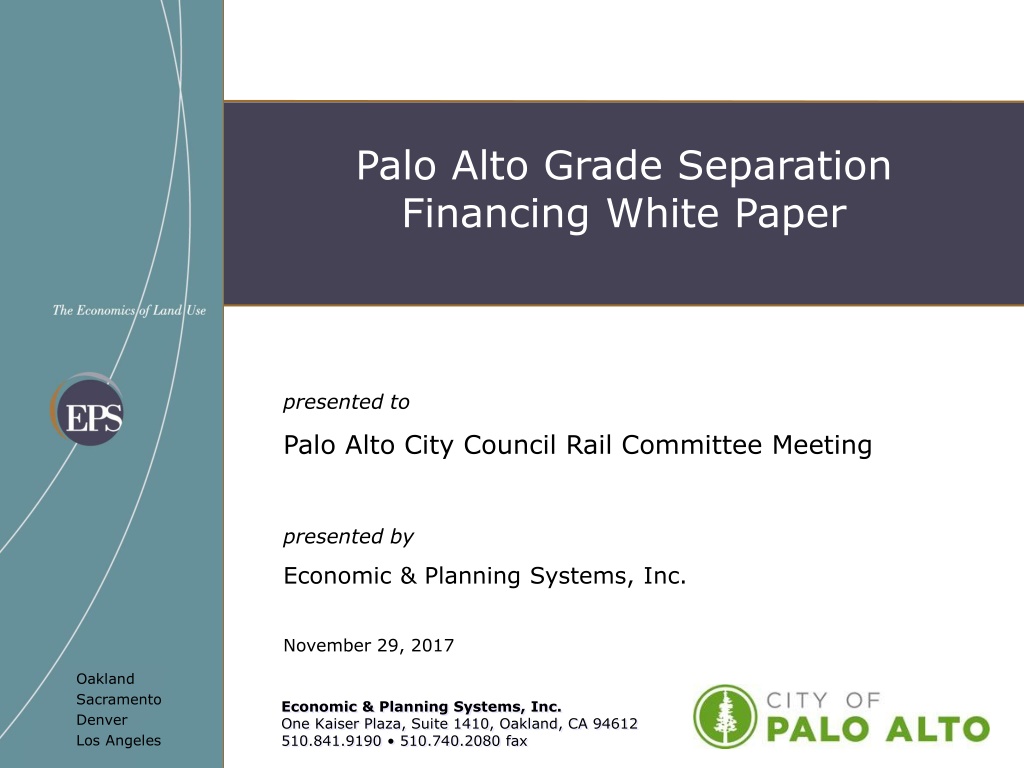
 undefined
undefined





















